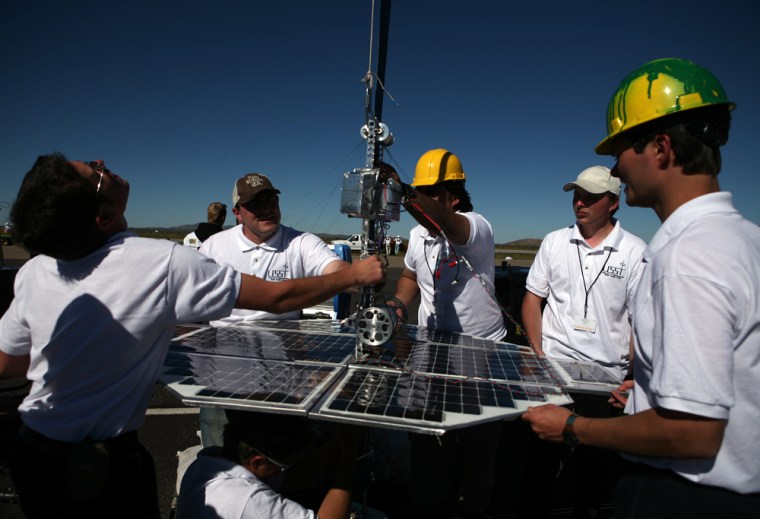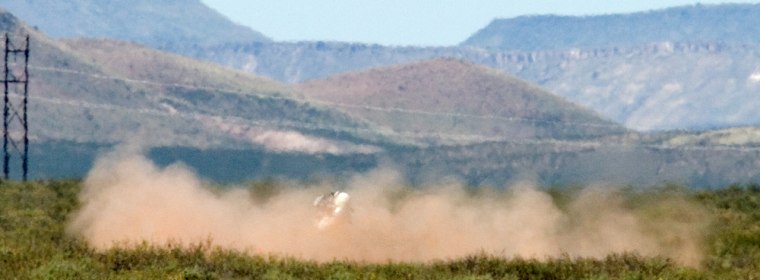LAS CRUCES, N.M. - The competitions at a New Mexico rocket festival went to the bitter end and beyond on Saturday.
The Wirefly X Prize Cup ended in disappointment for Texas-based Armadillo Aerospace, which made two unsuccessful bids to win a $350,000 prize in the Northrop Grumman Lunar Lander Challenge. Its lunar lander prototype, nicknamed Pixel, missed a landing pad during one attempt and flipped over on its side during the other.
Meanwhile, the Space Elevator Games — another marquee event at the X Prize Cup — went into overtime. A $200,000 "tug of war" for super-strong materials was conducted on Saturday night, but that money went unwon. Several competitors were due to try their hand at sending robotic climbers up a long ribbon on Sunday, in hopes of winning a share of another $200,000, and judges were considering overnight whether one of the contestants actually rated winning a prize.
The Lunar Lander Challenge and the Space Elevator Games are part of NASA's Centennial Challenges program, aimed at encouraging the development of technologies for the space agency's planned return to the moon by 2020.
The contests were by no means the only events unfolding at the X Prize Cup, which got its start on Friday. Thousands of spectators thronged to the airport to take in amateur rocket launches, jet flyovers and exhibits dedicated to the proposition that everyone could someday have a chance to go to outer space.
Ups and downs for lunar lander
It was a day of ups and downs for Armadillo's Pixel lunar lander prototype, which had suffered damage on Friday during its first attempt to win the $350,000 first prize in the Lunar Lander Challenge's Level 1 contest.
To win the money, Armadillo had to get the rocket-powered, remote-controlled Pixel to lift off, rise to at least 50 meters (164 feet), hover for 90 seconds, then come down on a flat, circular target pad 100 meters (328 feet) away. Then Pixel had to lift off again and make its way back to the starting point.
It was that last step that Armadillo missed on Friday. Armadillo's team leader and remote operator, John Carmack, said the lander came down "a little too hard," breaking off the feet on the vehicle's legs and damaging the rocket's engine chamber. Flames from the engine burned through some of the craft's circuitry, he said.
Overnight, team members took the feet of its other lander prototype, dubbed Texel, and put them on Pixel. Carmack, a millionaire video-game programmer, rewrote the control software for a softer landing. Pixel's circuitry was patched up, and the damaged chamber was replaced with a backup.
On Saturday morning, Armadillo's second attempt produced a spectacular 112-second flight — but Carmack just missed the target pad, and Pixel ended up sitting askew in the weeds.
The team quickly geared up for a third attempt, and this time Pixel landed on the target pad, about 8 inches (20 centimeters) from the pad's edge. But one of its four landing legs broke off.
The rules of the challenge didn't allow a repair to the leg. "We figured, 'What the heck, we'll go ahead and try it with a broken leg," Carmack said.
So Armadillo workers quickly made adjustments and refueled Pixel for the crucial return trip. The broken leg was set in place under one of the tanks to keep the craft level for launch. But when the craft began to lift off again, the broken leg fell away. That made Pixel go off-level, which tripped off the craft's abort limits and caused an engine shutdown. Within seconds, Pixel twisted in the air and toppled back to the ground.
The mishap ended Armadillo's chances for the year. That means all the money in the $2 million challenge — including cash that NASA had set aside for a more difficult challenge as well as prizes for potential runners-up — will be rolled over to next year's X Prize Cup.
Armadillo team member Phil Eaton said the lessons learned with Pixel should benefit future rocket endeavors, even though the money went unwon. "All of those things really work out to benefit all of us," he said.
As for Pixel, Carmack said the lander was "probably down for the count now."
"We'll hang it up someplace in our shop," he said.
Second floor for Elevator Games
Meanwhile, more than a half-dozen teams involved in the $400,000 Space Elevator Games put in a full day. The Beam Power Challenge requires teams to build robot that can run off solar power or directed beams of light or microwaves, and carry a payload up a 50-meter-long (164-foot-long) ribbon in less than a minute. Another competition, the Tether Challenge, is designed for new types of super-strong ribbon materials.
The Space Elevator Games got their start last year in California, but this year marks the first time the competitions have been conducted at the X Prize Cup in New Mexico. NASA says the technologies could lead to better power sources, interplanetary rovers and construction materials — but those technologies also could be used to build "space elevators" for dramatically cheaper access to orbit, proponents say.

On Saturday, one team, representing the University of Saskatchewan, reached the top of the 50-meter ribbon in 58 seconds — which might well have satisfied the main provision in the rules. The judges were reviewing the precise distance covered by the climber and its speed, as well as checking whether it followed all of the contest's other provisions.
"The speed is on the edge," judge Isaac Mazor told MSNBC.com. A ruling was expected on Sunday.
Two other teams — Germany's TurboCrawler team and the LiteWon team from California's Westmont High School — made it all the way up on Saturday, although they didn't do it within the one-minute limit. LiteWon actually notched two complete trips, at five and a half minutes and a little more than two minutes.
Ken Davidian, a spokesman for NASA's Centennial Challenge, said the high school team's showing proved that there's no age limit on innovation. "New sources of innovation can come from anywhere," he told MSNBC.com.
Games go into overtime
The games went into overtime in part because Toronto-based Punkworks and Utah-based Centaurus planned to power their robots with microwave beams — but the airport ruled out using such equipment on its grounds. So the Space Elevator Games' organizers moved their equipment, including a giant crane, to Las Cruces' fairgrounds after the X Prize Games to finish that competition on Sunday.
"The money might be won over there, not here," Punkworks team leader Allen Atamer told MSNBC.com. In addition to Punkworks and Centaurus, three other teams — LiteWon, StarClimber and the Kansas City Space Pirates — would also get opportunities for climber runs.
The Tether Challenge, which is the other half of the Space Elevator Games, was conducted at the fairgrounds Saturday night. No one won the $200,000 prize, but California-based Team Astroaraneae's tether material handled up to 1,335 pounds of force, besting last year's "house tether."
Astroaraneae team leader Michael Remington told MSNBC.com that the innovations behind the tether "may actually be implemented in future technology at Aerojet," the company where team members work.
Unfortunately for Astroaraneae, this year's house tether stood up to 1,661.7 pounds of force — so much tension that the machine testing the tether broke before the tether did. So the Tether Challenge's $200,000, like the Lunar Lander Challenge's $2 million, will roll over to next year.
Quick blasts
While some focused on winning prizes, others celebrated the space frontier with loud noises and rocket blasts. The amateur Tripoli Rocketry Association launched several rockets, an F-117 stealth fighter and an F/A-18 jet streaked through the sky, and the hiss of XCOR Aerospace's "teacart" rocket could be heard repeatedly.
Among Saturday's other highlights:
- Nancy Conrad, the widow of astronaut Pete Conrad, announced the establishment of the Pete Conrad Spirit of Exploration Award, which will be given out at future X Prize Cups. Two trophies — handcrafted rockets by Erik Lindbergh, the grandson of aviation pioneer Charles Lindbergh — would be given to adult and student rocketeers annually. "It's about creating designs and concepts for new space vehicles," Conrad said. The rules for the awards are still being set, but Conrad said the public would help choose the winners. "This is a way to take Pete's legacy and spread it across the country," she said.
- The Rocket Racing League announced the creation of a third sponsored team for its rocket-powered airplane races, due to begin next year. The new team is Santa Fe Racing, headed by New Mexico land developer Marc Cumbow. "It's going to be the fastest spectator sport out there," Cumbow told reporters. Cumbow said his father, Edward Cumbow, would be co-owner. Granger Whitelaw, the league's chief executive officer, said the Cumbows have paid $100,000 toward the $1.4 million cost of a rocket plane and its support equipment. The two other sponsored teams are the Leading Edge Racing Team and the Bridenstine Rocket Racing Team.
- Masten Space Systems' rocket engine roared to life for a 94-second-long static firing. Masten had hoped to compete in the Lunar Lander Challenge but dropped out, having decided its craft couldn't be ready in time this year. Michael Mealling, Masten's vice president for business development, pointed out that Saturday's firing could have been part of a winning effort. "The only reason we didn't go longer is because we ran the tanks dry," he told MSNBC.com.
- One of the fan favorites was Rocketman Dan Schlund, who wowed the crowds with a 30-second rocket-belt demonstration. "I get to live the space dream vicariously through the rocket belt," Schlund told MSNBC.com. Children flocked around Schlund after his performance, and 9-year-old Isaiah Mogaña paid him the highest praise: "He was as cool as any superhero."
